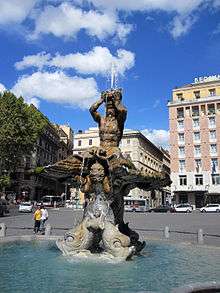Fontana del Tritone

Fontana del Tritone (Triton Fountain) is a seventeenth-century fountain in Rome, by the Baroque sculptor Gian Lorenzo Bernini. Commissioned by his patron, Pope Urban VIII, the fountain is located in the Piazza Barberini, near the entrance to the Palazzo Barberini (which now houses the Galleria Nazionale d'Arte Antica) that Bernini helped to design and construct for the Barberini, Urban's family.[1] This fountain should be distinguished from the nearby Fontana dei Tritoni (Fountain of the Tritons) by Carlo Francesco Bizzaccheri in Piazza Bocca della Verità which features two Tritons.
The fountain was executed in travertine in 1642–43. At its centre rises a larger than lifesize muscular Triton, a minor sea god of ancient Greco-Roman legend, depicted as a merman kneeling on the sum of four dolphin tailfins. His head is thrown back and his arms raise a conch to his lips; from it a jet of water spurts, formerly rising dramatically higher than it does today. The fountain has a base of four dolphins[2] that entwine the papal tiara with crossed keys and the heraldic Barberini bees in their scaly tails.[3]
The Tritone, the first of Bernini's free-standing urban fountains, was erected to provide water from the Acqua Felice aqueduct which Urban had restored, in a dramatic celebration. It was Bernini's last major commission from his great patron who died in 1644. At the Triton Fountain, Urban and Bernini brought the idea of a sculptural fountain, familiar from villa gardens, decisively to a public urban setting for the first time; previous public fountains in the city of Rome had been passive basins for the reception of public water.
Bernini has represented the triton to illustrate the triumphant passage from Ovid's Metamorphoses book I, evoking godlike control over the waters and describing the draining away of the Universal Deluge. The passage that Urban set Bernini to illustrate, was well known to all literate Roman contemporaries:
- Already Triton, at his call, appears
- Above the waves; a Tyrian robe he wears;
- And in his hand a crooked trumpet bears.
- The sovereign bids him peaceful sounds inspire,
- And give the waves the signal to retire.
- His writhen shell he takes; whose narrow vent
- Grows by degrees into a large extent,
- Then gives it breath; the blast with doubling sound,
- Runs the wide circuit of the world around:
- The sun first heard it, in his early east,
- And met the rattling ecchos in the west.
- The waters, list'ning to the trumpet's roar,
- Obey the summons, and forsake the shore.
- —free translation by Sir Samuel Garth, John Dryden, et al..
Two finished terracotta bozzetti at the Detroit Institute of Arts,[4] securely attributed to Bernini, reflect his exploration of the fountain's themes of the intertwined upended dolphins and the muscular, scaly-tailed Triton.
Subsequent history

The Triton Fountain is one of those evoked in Ottorino Respighi's Fontane di Roma. The legend applied to Trevi Fountain has been extended to this: that any visitor who throws a coin into the water (while facing away from the fountain) will have guaranteed their return to Rome.
The setting of the Piazza Barberini has changed significantly since the seventeenth century. Engravings of the time and photographs from the nineteenth century show much lower buildings around the piazza, which would have made the fountain much more dramatic. However, it is a tribute to the artistic judgement of Bernini that even now, with tall buildings around the traffic-ridden piazza, that the Triton Fountain can still maintain a dramatic presence.
References
- ↑ The Palazzo Barberini was built according to a plan by the architectCarlo Maderno. When Maderno died in 1629, Bernini took over supervising its construction. Both the fountain and palace are close to Borromini's San Carlo alle Quattro Fontane
- ↑ The dolphins are represented in their heraldic conventionalization, not as they appear in nature.
- ↑ Two finished terracotta bozzetti at the Detroit Institute of Arts, (accession numbers 52.218 and 52.219) securely attributed to Bernini, reflect his exploration of the fountain's themes of the intertwined upended dolphins and the muscular, scaly-tailed Triton.
- ↑ Accession numbers 52.218 and 52.219.
External links
| Wikimedia Commons has media related to Fontana del Tritone (Rome). |
- Web Gallery of Art: image and description
- (Mary Anne Sullivan), photographs of the Triton Fountain
- Bernini bozzetti: Detroit Institute of Art
Coordinates: 41°54′13″N 12°29′18″E / 41.90361°N 12.48833°E